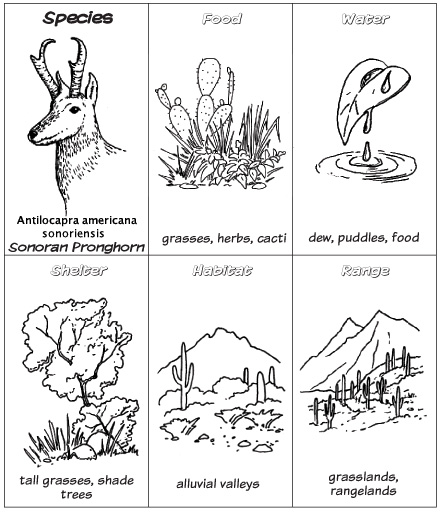

Directions: Print two copies of the card, then select the remaining cards from the Learning Materials menu.


Sonoran Pronghorn Antelope - Antilocapra americana sonoriensis
Description: The Sonoran Pronghorn Antelope is a desert sub-species of the antelope family. The upper parts of the Pronghorn are tan, while the underpart, rump, and two bands across the neck are white. The male has two black cheek patches and black horns. Both sexes have horns, though males have larger horns. Males weigh from 100 to 130 pounds, while females weigh 75 to 100 pounds. Pronghorn are well adapted for speed and predator detection. The antelope can run as fast as 60 miles per hour.
Habitat: Within the Sonoran desert, the antelope is found in broad, alluvial valleys separated by granite mountains and mesas. Vegetation is scarce throughout most the Sonran pronghorn's habitat, due to little and sporadic rainfall.
Range: Historically, the Pronghorn inhabited southwest Arizona and the northern part of Sonora, Mexico.
Diet: The Sonoran pronghorn feeds on herbs, cacti, and desert grasses. Similar to cows, the pronghorn has a rudiment stomach, or a four part stomach. This is especially beneficial to the antelope because it allows for the digestion of roughly textured foods (cacti and other desert plants) and allows for a high level of water retention. The antelope have evolved in an environment with little to no drinking water available at all times of the year. They drink when water is available, otherwise, their water needs appear very low.
Reproduction: Does are ready to mate at 16 months and bucks are ready by one year of age. The Sonoran pronghorn breed from July thru September. 2 Gestation is about 245 days. At birth, fawns weigh from five to seven pounds.
Status: The Sonoran pronghorn has been listed federally endangered since June 2, 1970.
Return to the Sonoran Desert Endangered Species Card Game

 Go to quick links
Go to quick search
Go to navigation for this section of the ToL site
Go to detailed links for the ToL site
Go to quick links
Go to quick search
Go to navigation for this section of the ToL site
Go to detailed links for the ToL site